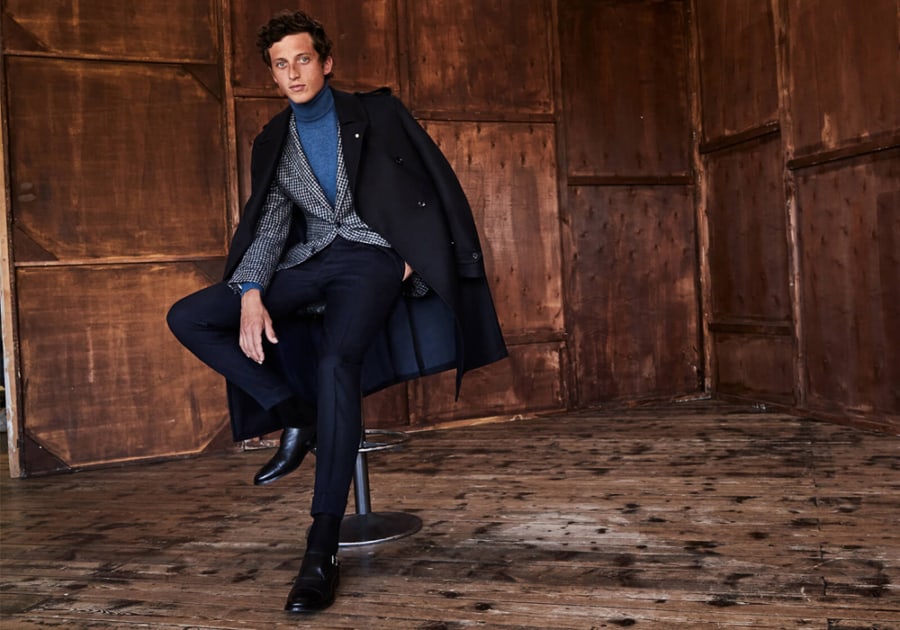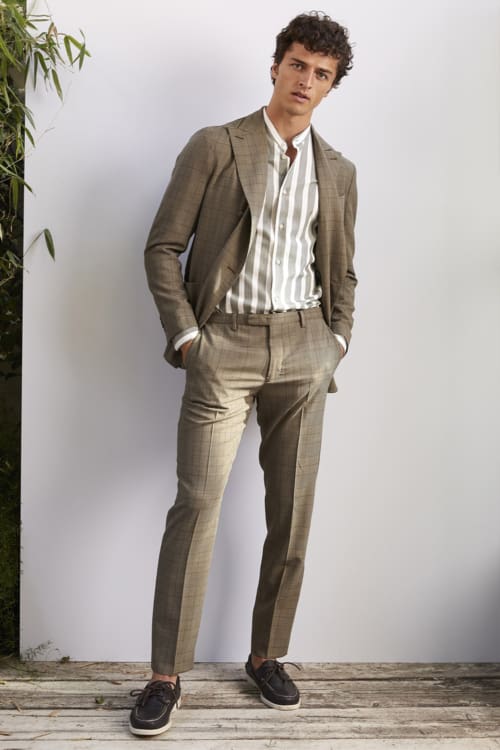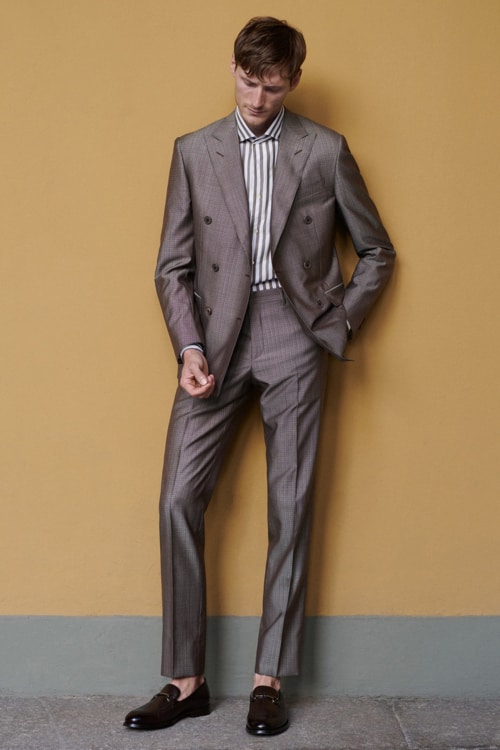
The Cocktail Attire Dress Code: A Modern Man’s Guide For 2024
Black tie’s less formal younger brother is back on the menu. Here's how to ensure you don’t look shaken or stirred.
‘Cocktail attire’: two of our favorite words, commingling the worlds of simultaneously looking good and getting rapidly drunk while reveling in the conceit of sophisticated socializing. What’s not to like? Well, the hangover for one, as anyone who has excitedly sunk top-shelf spirits in record time can testify.
Then there’s the dress code, which describes everything and nothing in two neat little words. Dressy, but not ‘black tie’ dressy. Smart, but make it fun. Classic, only with a contemporary twist. OK, then. Glad that’s clear.
Defining cocktail attire in a single sentence is like asking a room full of five-year-olds to draw a dog: sure, you’ll get plenty of floppy ears, but everything else is a matter of interpretation.
Don’t let that perturb you though. In fact, creative license within a relatively narrow remit is the best possible scenario – you get a broad sartorial canvas with a limited but not limiting array of paints with which to daub. That’s enough of the metaphors for now.
Let’s learn the rudiments of cocktail attire so that the next time you receive an invitation for such an evening event, you rejoice rather than recoil.
What is cocktail attire?
It’s as slippery as an eel at a jelly party is what it is. In short, it’s an eyeballed measure of tailoring (but never a business suit), a single shot of casual sophistication (we’re looking at you fine gauge turtleneck), shaken with equal parts fun and extravagance, and finally garnished with a slice of glamour.
Cocktail attire is more commonly based around tailored separates, but suits are absolutely applicable so long as they are non-business related – rocking up in your 9-5 charcoal suit and black Oxfords and simply leaving your tie in your pocket does NOT constitute cocktail attire.
A minimalist black suit and black silk polo is something different altogether, though. Ditto a burgundy linen double-breasted suit with contrast shirt and flamboyant tie. You see where we’re going with this? Cocktail attire is ‘special’ and open to creative interpretation within the remit of ‘smart’. The question you need to ask, essentially, is: does it look like I’ve made a special effort? If the answer in yes, then it’s cocktail time.
When do you wear cocktail attire?
Given none of us move in the social circles of the 1920s middle class, suffice to say that our collective mantelpieces are not bowing under the weight of cocktail party invitations. And yet, while the cocktail party might not be such a ‘thing’ today, many events and occasions demand cocktail attire by proxy.
Think evening wedding receptions, special birthday parties, awards ceremonies, galas, Christmas events, networking evenings and yes, whenever the hell you want to get dressed up and feel good about it.
The key elements of cocktail attire
As loosely interpreted the tenets of cocktail attire are, like any dress code there are certain boundaries one would be wise to play within. Creativity is one thing, flagrant rule-bending is quite another. So below we’ve defined what we think are the best options for a modern wardrobe.
From the suit and separates to the shirt, top, shoes and accessories, apply this knowledge with verve and panache and your cocktail attire will be top shelf.
The suit
As previously mentioned, the cocktail suit is no ordinary charcoal 9-5 number. Instead, you’ll want something more characterful and flamboyant, but equally sophisticated. Darker colors are preferable given you’ll likely be wearing it to evening events, so tones such as burgundy, dark green, black and blue are good and versatile options.
Opt for seasonal fabrics where you can. Linen is a beautifully textural cloth for the summer, whereas corduroy, velvet and wool flannel make for tactile options in fall and winter.
As far as the suit style goes, broader peak lapels in that classic Neapolitan style have that much more panache than a notch lapel jacket, but if you want a smart contemporary cocktail look, then a slimmer peak or notch lapel will suffice.
You can also be a bit more creative with cloth types – embrace patterns such as herringbone and checks, but avoid pinstripes due to their association with bankers and stuffy corporate environments.
The blazer
The separates route is one well travelled when it comes to cocktail attire, which puts much of the onus of the look on the blazer. Just as well because one can get really creative with both single and double-breasted styles.
At the smarter end of the sartorial spectrum, dressing down a velvet dinner jacket is a very debonair look. Cotton velvet styles in black, navy, burgundy, tobacco, burnt orange, pink and racing green are all excellent options when matched with black tailored trousers.
For a more casual but no less tactile slant, opt for corduroy or a brushed flannel cloth. Separates are where the double-breasted jacket comes into its own, especially with well-sized peak lapels. An ivory or bold check DB blazer can be a real show-stopper when worn with a classic stand collar shirt or fine-gauge merino roll neck (more on those below).
And definitely embrace patterns – checks, stripes, embroidery – which will add to the personality of the look.
The trousers
The trousers are the easy part because where your jacket is expressive, your bottom half should be muted. Elegantly tailored flat-fronted styles with a flattering taper are a nice choice if you want to go for a smarter classic look, while single- and double-pleated options are a bit more casual, which is no bad thing either.
Black (or white in summer) is the failsafe color to go for, but if you want to mix it up a bit, then various shades of grey will also work well. Just remember that if your blazer is bold then your trousers should be barely seen and definitely not heard.
The shirt
A smart stand-collar cotton shirt worn with or without a tie is the way to go in most instances because it provides structure and frames the face well. Don’t be tempted by a dress shirt – it’s just too formal.
Rather than reaching for formality, your shirt can also be quite expressive, say with a pinstripe or a polka dot or other pattern, provided your blazer isn’t already embellished with something similar.
Pastel tones can work in the summer with light-coloured blazers such as ivory, but they don’t carry enough substance the rest of the time. Instead, try dark tonal shirts with your darker cocktail looks for a sophisticated finish.
The shirt alternative
While we love a great shirt, cocktail attire doesn’t have to be married to the idea of collar and cuffs. The merino turtleneck has, for example, long been considered a worthy alternative to wear with a smart blazer or suit, given its minimal styling and neck construction, which naturally complements the blazer’s lapels.
It’s especially effective in dark tones worn with similarly dark tones – think a forest green roll neck with a burgundy velvet dinner jacket or a charcoal roll neck and ivory flannel blazer combo. Just make sure you go for the most lightweight merino or cashmere that you can find, otherwise you’ll self-combust.
Similarly, knitted polos are a smart deviation from the classic shirt, dressing down the look with that soft roll collar, two/three-button placket and subtle knitted texture. Avoid bright contrast tones as this will look too jarring against a darker blazer – a better bet would be to wear a tone similar to the blazer, or at least in the same neighborhood.
The plain T-shirt is by far the most casual alternative but it can certainly hold its own as a relaxed layer that doesn’t distract from your tailoring. Please, only crew neck versions, and definitely no patterns or logos. A simple black, white, navy or dark tone tee cut from heavyweight cotton or, better yet, knitted merino can be an excellent riposte to the smart cut of a blazer or suit jacket.
The shoes
If cocktail attire is about sophisticated playfulness, then the somber Oxford shoe should be parked for the evening in favor of the much more exuberant monk, double-monk, buckle or tassel loafer, and velvet slippers. Each of these styles has a good deal more character than the uptight Oxford and is certainly less formal.
Black calf leather will work with most trouser styles, while you might be able to team a tan leather or suede style with a lightweight blazer or suit in the summer. As for Chelsea boots, well, they’re questionable in most cases – you’d have to turn up in a particularly fine pair to cut the mustard.
Sneakers are a ‘no’ for us simply because they don’t tick the ‘special effort’ box.
The accessories
Where a lot of guys get flustered with cocktail attire is neckwear – to wear a tie or not? In short, a tie is absolutely not necessary, and if you feel like the options you have in your wardrobe are too ‘business,’ then definitely avoid it. An open collar is more relaxed and comfortable at any rate. That said, if you’re going for a dark tonal look, then a knitted silk tie might be the perfect way to add a touch of texture to the look.
A pocket square is often associated with black tie since it’s a vital component, but you’re missing a trick by not wearing one with your cocktail attire. That flash of lazily stuffed (or neatly folded) silk in your breast pocket throws off the symmetry of the look to create a more rakish, party-ready aesthetic overall.
Well-considered jewelry and a statement watch are the final pieces of the cocktail attire puzzle, but please, no outrageous bling. Understatement contributes more than enough status signaling. A sleek and minimalist metal bracelet or a subtle yet chic beaded style provides a nice contrast to the polished suit or separates, whereas a slim, classically styled dress watch that doesn’t affect the line of your sleeve is a nice touch.
Cocktail attire styling tips
Pattern
Classic checks, herringbone, houndstooth, pinstripes and embroidery work well with blazers if you intend to wear separates. Where suits are concerned, opt for subtle patterns such as twill and sharkskin. The cut and color of the suit should do most of the talking, whereas with separates, you have more license to be flamboyant with patterns.
Where shirts are concerned, patterns can be more liberally adopted so long as you don’t clash them. A subtle black tonal paisley shirt to wear with a black velvet jacket is a great combination of pattern complementing texture.
Texture
You can’t get enough of it. Texture is your trump card when it comes to cocktail attire as it brings depth to your layers and each part of your look to life. Corduroy, velvet, linen, tweed, hopsack… it’s all game, especially when you’re putting together a monochrome look.
Tonality
A tonal look is a very easy styling trick that offers a sophisticated and elegant vibe perfect for cocktail attire. A rich green linen suit worn with an even darker green turtleneck and oxblood loafers is the kind of tonal we can get behind.
Monochrome outfits are dashing too: an ivory double-breasted jacket paired with a white tee, black trousers and black buckle loafers mixes up high and low really well.
The origins of the cocktail party
The genesis of the cocktail party goes some way to explain its lively connotations and reputation as an occasion between afternoon tea and dinner to imbibe with style if not grace. Legend has it that the first ever ‘cocktail party’ was held by Clara D.D. Bell Walsh, also known as Mrs. Julius S. Walsh Jr, in St. Louis in 1917.
Mrs Walsh was by all accounts a lady of hedonistic principles who was not content with the social condemnation of women who drank publicly. In truth, Walsh’s knees-up probably wasn’t the first cocktail party per se, but it was the first to be held on a Sunday afternoon, which perhaps shows just how determined Mrs Walsh was to stick it to Kentucky gender norms.
It’s also likely (though not proven) that Mrs. Walsh ordained the services of Tom Bullock, the first African-American and St. Louis local to write his own cocktail manual, The Ideal Bartender, in 1917. Up until then, ladies were perceived as great cocktail makers (for their husbands and his friends), but not cocktail drinkers. Walsh and her ilk were having none of that nonsense.
It’s perhaps for this reason that cocktail parties soon became bywords for irrefutable scandal, salacious parties and general immorality, with the Harrisburg Telegraph once labeling such attendees as ‘jeweled gin-suckers’. It took another American, this time failed actor James Beard, to take up the cocktail party mantel post-Prohibition repeal. Beard wrote a book that cleverly instructed how to introduce hor d’oeuvres and canapes to the mix, and all of a sudden morality was restored!
Over the pond, Evelyn Waugh’s brother Alec was fastidious in his claims that it was he who invented the cocktail party in 1924 as a means to wile away the nothing time between 5.30pm and 7pm. Either way, the cocktail party became an excuse for a strong drink, unbridled gossip and dainty finger food – and that’s pretty much how it is today.




























